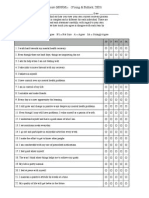Emdr Therapy Infographic 2
Uploaded by
api-633239836Copyright:
Available Formats
Emdr Therapy Infographic 2
Uploaded by
api-633239836Original Title
Copyright
Available Formats
Share this document
Did you find this document useful?
Is this content inappropriate?
Copyright:
Available Formats
Emdr Therapy Infographic 2
Uploaded by
api-633239836Copyright:
Available Formats
EMDR THERAPY
Eye Movement Desensitization and
Reprocessing
WHAT IS EMDR?
Developed in 1987
Therapy in which the patient focuses on a traumatic memory
briefly, while experiencing bilateral stimulation which is
usually eye movements. This may help the vividness of the
memory lessen.
EMDR therapy helps reduce the vividness and upsetting symptoms
of a memory. The therapist will have the patient focus on the
memory, while experiencing rhythmic left-right (bilateral)
stimulation. It is typically delivered one or two times per week for six
to twelve sessions. The therapy is an eight-phase approach.
The First Four stages
History-taking-
Preparing The Client
Assessment
Desensitization
The Last Four Stages
Installation
Body Scan
Closure
Re-evaluation
How EMDR Can Help Vietnam Veterans and others with PTSD
Many people and veterans have or have dealt with PTSD at some point. So,
this type of therapy may help. It will help stop the vividness of the memories,
so it's easier to continue with daily life.
Main Source
https://www.apa.org/ptsd-guideline/treatments/eye-movement-
reprocessing
Secondary
Source
https://www.emdria.org/about-emdr-therapy/
"Eye Movement Desensitization and Reprocessing (EMDR) therapy (Shapiro, 2001)
was initially developed in 1987 for the treatment of posttraumatic stress disorder
(PTSD) and is guided by the Adaptive Information Processing model (Shapiro 2007)."
This means that EMDR was developed after the Vietnam war, so veterans didn't
have this therapy right away.
"Unlike other treatments that focus on directly altering the emotions, thoughts and
responses resulting from traumatic experiences, EMDR therapy focuses directly on
the memory, and is intended to change the way that the memory is stored in the
brain, thus reducing and eliminating the problematic symptoms."
This can help veterans with PTSD continue with daily life. PTSD is a daily struggle. By
meeting one-two times per week, for six to twelve sessions, this therapy can help
eliminate troubling feelings and vividness of everything. I see this kind of therapy as
a way to try something new.
"While clients briefly focus on the trauma memory and simultaneously experience
bilateral stimulation (BLS), the vividness and emotion of the memory are reduced."
Some people speculate whether or not the bilateral stimulation helps. The bilateral
is typically eye movements, but can be tones or taps. The vividness going away can
help to stop people from reliving their trauma as frequently.
"EMDR therapy uses a structured eight-phase approach that includes:
Phase 1: History-taking
Phase 2: Preparing the client
Phase 3: Assessing the target memory
Phases 4-7: Processing the memory to adaptive resolution
Phase 8: Evaluating treatment results"
The phases go through introducing and preparing the client for the therapy, going
through the therapy, then finding out the results. The different stages help in
different ways. The first two stages go through evaluating the client and walking
them through the procedure. The third and fourth are starting the therapy by having
the client think about the event while experiencing bilateral stimulation. Five and six
help reinforce positive thinking, and figuring out how the client feels. Seven is the
end of the session, and eight is where the next session begins. Also, using these
different stages can help breakdown the therapy process.
You might also like
- The Subtle Art of Not Giving a F*ck: A Counterintuitive Approach to Living a Good LifeFrom EverandThe Subtle Art of Not Giving a F*ck: A Counterintuitive Approach to Living a Good Life4/5 (6055)
- The Gifts of Imperfection: Let Go of Who You Think You're Supposed to Be and Embrace Who You AreFrom EverandThe Gifts of Imperfection: Let Go of Who You Think You're Supposed to Be and Embrace Who You Are4/5 (1142)
- Never Split the Difference: Negotiating As If Your Life Depended On ItFrom EverandNever Split the Difference: Negotiating As If Your Life Depended On It4.5/5 (917)
- Hidden Figures: The American Dream and the Untold Story of the Black Women Mathematicians Who Helped Win the Space RaceFrom EverandHidden Figures: The American Dream and the Untold Story of the Black Women Mathematicians Who Helped Win the Space Race4/5 (946)
- The Hard Thing About Hard Things: Building a Business When There Are No Easy AnswersFrom EverandThe Hard Thing About Hard Things: Building a Business When There Are No Easy Answers4.5/5 (361)
- Devil in the Grove: Thurgood Marshall, the Groveland Boys, and the Dawn of a New AmericaFrom EverandDevil in the Grove: Thurgood Marshall, the Groveland Boys, and the Dawn of a New America4.5/5 (273)
- The World Is Flat 3.0: A Brief History of the Twenty-first CenturyFrom EverandThe World Is Flat 3.0: A Brief History of the Twenty-first Century3.5/5 (2283)
- A Heartbreaking Work Of Staggering Genius: A Memoir Based on a True StoryFrom EverandA Heartbreaking Work Of Staggering Genius: A Memoir Based on a True Story3.5/5 (233)
- Creating An Appropriate Learning EnvironmentNo ratings yetCreating An Appropriate Learning Environment9 pages
- How Feeling Like An Imposter Impacts Your Learning - Dr. Jasjit Sangha (10.06.20)No ratings yetHow Feeling Like An Imposter Impacts Your Learning - Dr. Jasjit Sangha (10.06.20)1 page
- Children's Drawings: A Mirror To Their MindsNo ratings yetChildren's Drawings: A Mirror To Their Minds16 pages
- Victoria University Business School: Joe - Traficante@vu - Edu.auNo ratings yetVictoria University Business School: Joe - Traficante@vu - Edu.au5 pages
- Strategic and Effective Communication and Influencing Skills SlidesNo ratings yetStrategic and Effective Communication and Influencing Skills Slides35 pages
- HIC Learning Module: Holy Infant CollegeNo ratings yetHIC Learning Module: Holy Infant College9 pages
- Interpreting and Analyzing The QuestionnaireNo ratings yetInterpreting and Analyzing The Questionnaire5 pages
- Minnesota Sexuality Education Resource Review Panel: Educator's Guide To Reproductive HealthNo ratings yetMinnesota Sexuality Education Resource Review Panel: Educator's Guide To Reproductive Health2 pages
- Let Us Enjoy Our Leisure Through Recreational GamesNo ratings yetLet Us Enjoy Our Leisure Through Recreational Games15 pages
- Seven Steps To Successful Strategic PlanningNo ratings yetSeven Steps To Successful Strategic Planning4 pages
- Pragmatism in Education: Sakshi Sharma Rajesh Devi Jyoti KumariNo ratings yetPragmatism in Education: Sakshi Sharma Rajesh Devi Jyoti Kumari6 pages
- Love_ More like Loneliness (Phil Paper #1)No ratings yetLove_ More like Loneliness (Phil Paper #1)4 pages






































































